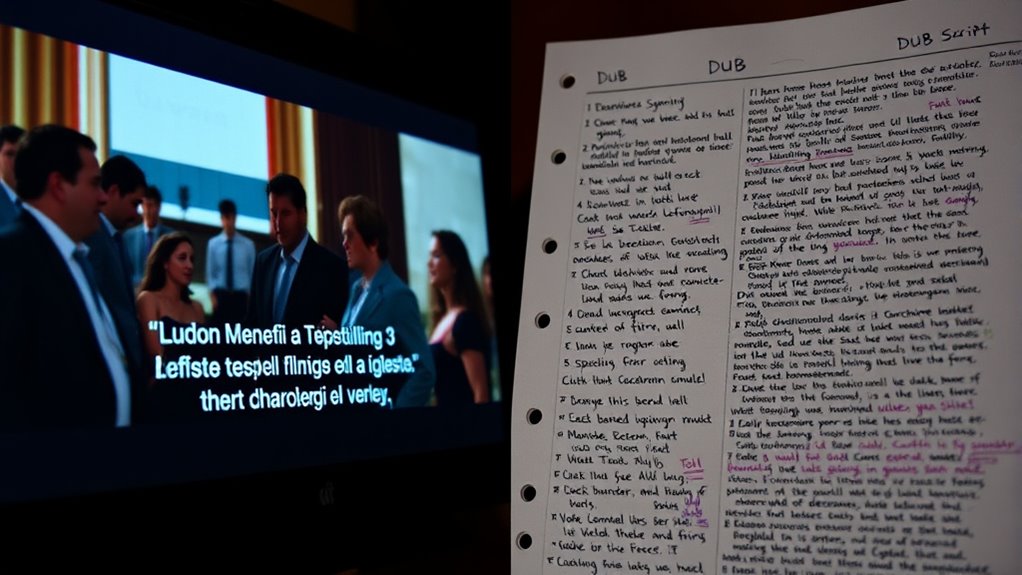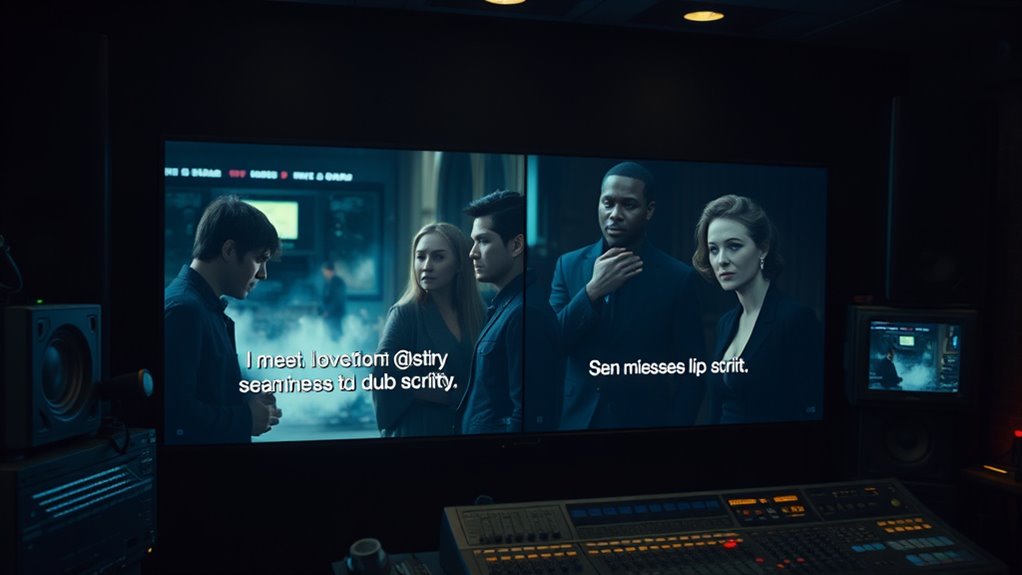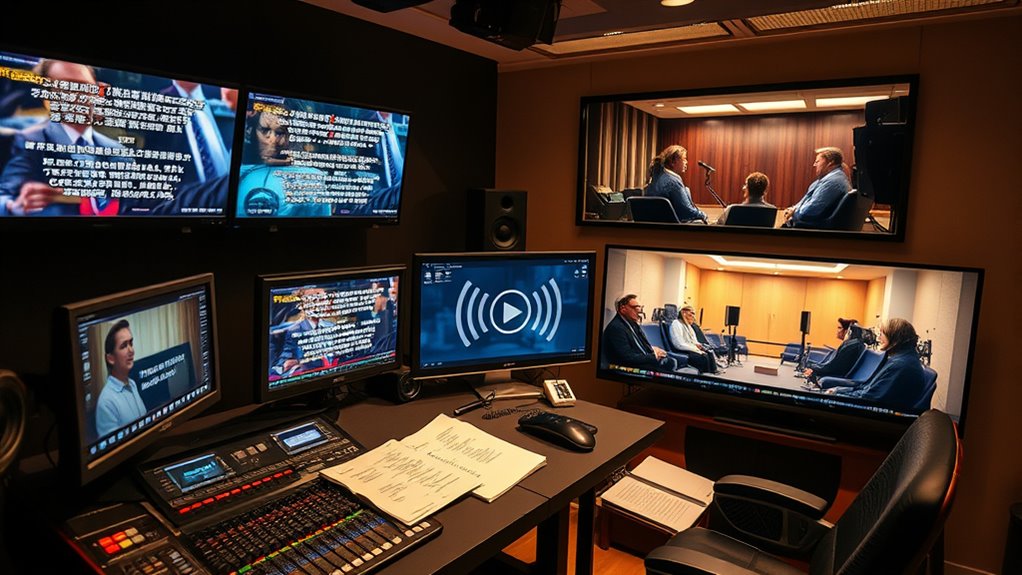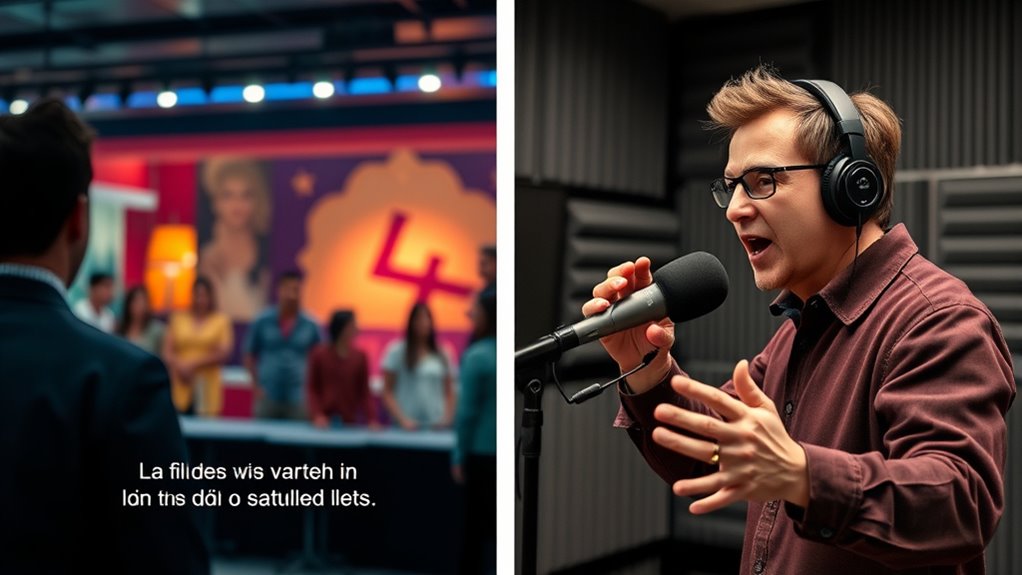Subtitling and dubbing rely on different strategies to adapt audiovisual content. Subtitles focus on concise, culturally adapted text that matches the original speech’s meaning while fitting timing and space constraints. Dubbing replaces voices with localized performances, emphasizing seamless lip synchronization and emotional delivery. Both methods require balancing technical limitations with storytelling needs. To understand how these approaches differ in execution and effects, keep exploring the specific techniques behind each adaptation process.
Key Takeaways
- Subtitling emphasizes preserving original visual details and cultural nuances through condensed text, while dubbing focuses on seamless voice synchronization.
- Subtitles require concise language to fit limited screen space, whereas dub scripts adapt dialogue for lip-sync and natural speech flow.
- Subtitling maintains the original audio, leaving visual cues intact, whereas dubbing replaces voices, potentially obscuring visual expressions.
- Dubbing involves more technical resources, including voice actors and sound editing, making it generally more costly and time-consuming than subtitling.
- Cultural adaptation in subtitles often involves translation and contextual changes, while dubbing emphasizes voice performance to match character emotions.
The Core Objectives of Subtitling and Dubbing

While subtitling and dubbing serve the same purpose of making content accessible across languages, their core objectives differ considerably. Subtitling aims to preserve the original visual aesthetic, allowing viewers to see the performers’ expressions and background details, which enhances viewer accessibility. Subtitles provide a direct connection to the original performance, maintaining cultural nuances and emotional impact. Dubbing, on the other hand, replaces the original voices with local language voices, focusing on seamless synchronization with on-screen actions. This approach can sometimes obscure the visual aesthetic but offers a more natural viewing experience for those who prefer not to read. Ultimately, each strategy prioritizes different aspects of viewer accessibility and visual presentation, shaping how audiences engage with foreign content.
Translation Techniques and Language Adaptation

You need to ensure how translation techniques influence the clarity and impact of subtitles and dub scripts. Using condensed language helps maintain brevity without losing meaning, while cultural context integration ensures the content resonates with local audiences. Mastering these adaptations is key to effective communication across languages. Additionally, understanding regulatory standards can guide the adaptation process to meet regional requirements and improve overall effectiveness.
Condensed Language Usage
Condensed language is a crucial technique in subtitling and dubbing, allowing you to convey essential meaning within strict space and time constraints. By focusing on brevity constraints, you learn to simplify sentences without losing core messages. This process requires selecting the most impactful words and eliminating unnecessary details. In subtitles, every second counts, so you must prioritize clarity and accuracy while keeping the dialogue brief. Dubbing, on the other hand, offers more flexibility but still demands concise phrasing to match lip movements. Mastering condensed language helps ensure viewers understand the content quickly and effortlessly. Ultimately, this technique enhances communication efficiency across different media formats, ensuring the original message remains intact despite the limitations imposed by translation and timing.
Cultural Context Integration
Effective subtitling and dubbing require more than just condensing language; they also demand careful attention to cultural context. You need to understand how cultural nuances influence meaning and viewer perception. Cultural context shapes how jokes, idioms, and references are received, so you must adapt content thoughtfully. Cultural adaptation ensures that humor, emotions, and social cues resonate locally, avoiding misunderstandings or offense. When translating, consider the audience’s familiarity with specific customs or traditions, and modify dialogues accordingly. This process helps maintain the original’s intent while making it accessible and relevant. By integrating the cultural context accurately, you create a seamless viewing experience that respects both the source material and the target culture.
Synchronization and Timing Challenges

You’ll find that matching subtitles or dubbing scripts to on-screen action can be tricky, especially when timing doesn’t align perfectly. Timing alignment difficulties often force you to shorten or split lines, risking loss of meaning. Scene synchronization issues can disrupt the flow, making it hard for viewers to stay immersed in the story. Additionally, retail store hours variations and special hours during holidays can complicate scheduling and planning for production shoots or post-production adjustments.
Timing Alignment Difficulties
Timing alignment remains one of the most significant challenges in subtitling and dubbing, as each method requires precise synchronization between audio and on-screen text. For subtitlers, maintaining visual timing is vital so viewers can read comfortably without missing key moments. Dubbing artists, on the other hand, must match speech pacing to lip movements, making timing more complex. Both processes demand careful editing to ensure the text appears at the right moment and disappears smoothly. Small discrepancies can distract viewers or cause confusion. Achieving perfect timing involves adjusting the duration of subtitles or dub lines, balancing readability with synchronization. This challenge underscores the importance of meticulous timing adjustments to preserve the viewing experience and accurately convey the original content.
Scene Synchronization Issues
Scene synchronization issues pose significant hurdles beyond just timing adjustments. Achieving lip sync accuracy is vital, especially in dubbing, where mismatched mouth movements can distract viewers. In subtitling, ensuring that text appears at the right moment to match scene pacing is equally challenging. If subtitles lag or appear too early, they disrupt the flow, making it harder for viewers to stay engaged. Conversely, rushing subtitles can cause missed context or emotional impact. Balancing these factors requires precise timing and a keen understanding of scene rhythm. Both strategies demand careful synchronization to preserve the scene’s integrity. Whether aligning dialogue with lip movements or matching subtitles to scene transitions, addressing scene synchronization issues is essential for seamless viewing experiences.
Cultural Nuances and Localizations

Cultural nuances and localizations play a crucial role in how subtitles and dubbing resonate with audiences. When adapting content, you must consider idiomatic expressions that may not translate directly, guaranteeing they maintain their original meaning and impact. Humor adaptation is especially important, as jokes or cultural references often need rephrasing to be funny and relevant in the target culture. Subtitles require concise adjustments to preserve context without losing meaning, while dubbing can allow for more flexible rephrasing to match lip movements. Recognizing these nuances helps prevent misinterpretations and ensures the audience feels connected to the content. Ultimately, understanding cultural differences ensures your translations stay authentic, engaging, and culturally appropriate, making the viewing experience more immersive and enjoyable. Additionally, being aware of localization strategies can significantly enhance how well a film or show resonates with diverse audiences.
Voice Acting and Performance Considerations

How does voice acting influence the overall effectiveness of subtitles and dubbing? Your choice of voice actor profoundly impacts emotional expressiveness and audience engagement. When selecting voice actors, consider their ability to convey characters’ emotions authentically. Here are key points to keep in mind:
- Voice Actor Selection: Match voices to characters’ personalities for natural performances.
- Emotional Expressiveness: ensure actors can evoke the intended feelings clearly.
- Consistency: Maintain vocal tone throughout to preserve character identity.
- Cultural Fit: Choose voices that resonate with the target audience’s cultural context.
- Additionally, aligning voice performances with small mistakes, big impact in production can enhance overall authenticity and viewer satisfaction.
Technical Constraints and Formatting Standards

Technical constraints and formatting standards play a crucial role in ensuring that subtitles and dub scripts are effective and viewer-friendly. You need to contemplate font size carefully—if it’s too small, viewers struggle to read quickly; too large, and it distracts from the visuals. Line spacing is equally important, as it impacts readability and how smoothly the text appears on screen. Proper line spacing prevents clutter and makes each line easier to scan. These standards help maintain consistency across different content and platforms. Adhering to specific formatting guidelines ensures that subtitles and scripts are clear, legible, and synchronized with audio. Additionally, understanding font legibility is essential for creating accessible and comfortable viewing experiences. Ultimately, respecting these constraints improves viewer comprehension and enhances the overall viewing experience.
Audience Engagement and Viewing Experience

Effective subtitles and dub scripts do more than just display words; they shape how you connect with the story. They influence your visual immersion and emotional resonance, making scenes feel more authentic or accessible. Consider these aspects:
- Clarity of language enhances your understanding and keeps you engaged.
- Timing ensures you don’t miss key visual cues, maintaining immersion.
- Cultural adaptation can deepen emotional resonance by aligning with your context.
- Font and placement choices impact how seamlessly subtitles blend into visuals, affecting your overall viewing experience.
- The color accuracy of subtitles can also influence how natural and comfortable the viewing experience feels, especially in scenes with complex visuals.
Impact on Storytelling and Character Development

Subtitling strategies and dub scripts considerably influence how stories unfold and how characters come to life on screen. With dubbing, you rely on voice modulation and emotional expression to convey characters’ feelings, shaping their depth. Subtitles, however, depend on concise language, limiting emotional nuance but preserving original tone. This difference affects storytelling flow and character development. For example:
| Aspect | Dubbing | Subtitling |
|---|---|---|
| Voice modulation | Can vary to match character’s mood | Limited by text, less expressive |
| Emotional expression | Enhanced through tone and delivery | Conveyed through brief cues |
| Character depth | More immersive, thanks to voice nuances | Less detailed, relies on text cues |
| Story flow | Seamless, integrated with voice acting | Sometimes disjointed, due to translation |
| Audience connection | Stronger via vocal performance | Depends on translation accuracy |
Your understanding of these impacts helps you appreciate how storytelling adapts across translation methods. Additionally, accurate translation plays a crucial role in maintaining the integrity of character portrayal in subtitles, ensuring viewers grasp the intended nuance and emotional context.
Cost, Time, and Production Factors

Have you ever considered how the choice between subtitling and dubbing impacts production costs and timelines? Subtitling generally requires less budget and shorter production timelines because it involves translating text and syncing it with visuals. Dubbing, however, demands more resources due to voice actors, multiple recording sessions, and sound editing. To understand the differences, consider:
- Budget constraints: Dubbing is costlier due to talent and equipment.
- Time investment: Dubbing takes longer to produce than subtitling.
- Technical complexity: Dubbing involves voice synchronization, increasing production complexity.
- Post-production: Dubbing requires additional editing, unlike subtitling.
Your choice affects your project’s overall efficiency, especially when managing tight budgets and deadlines. Understanding these factors helps you decide which approach best aligns with your production goals. Additionally, voiceover skills are essential for dubbing, impacting the overall quality and authenticity of the final product.
Frequently Asked Questions
How Do Subtitling and Dubbing Influence Viewer Comprehension Differently?
You might notice that subtitling and dubbing influence your comprehension differently. Subtitles often prioritize linguistic accuracy, allowing you to read and understand dialogue while still engaging visually with the scene. Dubbing, however, replaces original voices, which can enhance viewer engagement but sometimes sacrifices linguistic accuracy. Your understanding depends on these strategies; subtitles keep the original performance intact, while dubbing offers a more seamless experience, though potentially less authentic.
What Are the Legal Considerations in Adapting Scripts for Subtitles Versus Dubbing?
Your adaptation process involves steering legal waters that are as treacherous as a stormy sea. When updating scripts for subtitles, you must be mindful of copyright limitations and make certain your translation respects language licensing agreements. Dubbing often requires even more careful legal considerations due to voice recordings and synchronization rights. Both methods demand strict adherence to copyright laws, but subtitles typically involve less complex licensing issues than full dubbing.
How Do Cultural Sensitivities Affect Subtitle Versus Dub Script Choices?
You need to take into account cultural sensitivities when choosing subtitle or dub scripts. Cultural adaptation plays a key role, as you must respect local customs and avoid offending viewers. Language nuances influence how you convey humor, idioms, or slang, making dubbing more flexible for cultural changes, while subtitles often stick closer to the original dialogue. Balancing authenticity with cultural appropriateness ensures your audience connects without misunderstandings or offense.
In Which Scenarios Is One Method Preferred Over the Other for International Audiences?
When choosing between subtitles and dubbing for international audiences, consider linguistic accuracy and audience engagement. If your goal is to preserve original speech nuance, subtitles are preferred, especially for viewers who value authentic performances. Conversely, dubbing is better when you want to enhance audience engagement by making content more accessible, especially for younger viewers or those who might struggle with reading. Select the method that best balances clarity and cultural authenticity for your target audience.
How Do Technological Advancements Impact Subtitling and Dubbing Practices?
Imagine the future where technology transforms your viewing experience. Automated translation and speech recognition now revolutionize subtitling and dubbing, making them faster and more accurate. You benefit from real-time translations, breaking language barriers effortlessly. These advancements streamline workflows, improve synchronization, and widen accessibility. As technology evolves, your entertainment becomes more immersive and inclusive, showing how innovation shapes the way you connect with stories across the globe—making every viewing moment seamless and engaging.
Conclusion
Understanding how subtitling and dubbing differ helps you appreciate the art behind each. Like two sides of the same coin, these methods shape your viewing experience uniquely—either by preserving authenticity or enhancing immersion. As you watch international content, remember that behind every line and voice, there’s a delicate balance of strategy and creativity. So next time, consider how these subtle choices craft your connection to stories across languages—truly a demonstration to the magic of translation.









